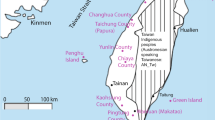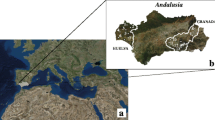Abstract
Length variation in the human mtDNA intergenic region between the cytochrome oxidase II (COII) and tRNA lysine (tRNAlys) genes has been widely studied in world populations. Specifically, Austronesian populations of the Pacific and Austro-Asiatic populations of southeast Asia most frequently carry the 9-bp deletion in that region implying their shared common ancestry in haplogroup B. Furthermore, multiple independent origins of the 9-bp deletion at the background of other mtDNA haplogroups has been shown in populations of Africa, Europe, Australia, and India. We have analyzed 3293 Indian individuals belonging to 58 populations, representing different caste, tribal, and religious groups, for the length variation in the 9-bp motif. The 9-bp deletion (one copy) and insertion (three copies) alleles were observed in 2.51% (2.15% deletion and 0.36% insertion) of the individuals. The maximum frequency of the deletion (45.8%) was observed in the Nicobarese in association with the haplogroup B5a D-loop motif that is common throughout southeast Asia. The low polymorphism in the D-loop sequence of the Nicobarese B5a samples suggests their recent origin and a founder effect, probably involving migration from southeast Asia. Interestingly, none of the 302 (except one Munda sample, which has 9-bp insertion) from Mundari-speaking Austro-Asiatic populations from the Indian mainland showed the length polymorphism of the 9-bp motif, pointing either to their independent origin from the Mon-Khmeric-speaking Nicobarese or to an extensive admixture with neighboring Indo-European-speaking populations. Consistent with previous reports, the Indo-European and Dravidic populations of India showed low frequency of the 9-bp deletion/insertion. More than 18 independent origins of the deletion or insertion mutation could be inferred in the phylogenetic analysis of the D-loop sequences.



Similar content being viewed by others
References
Andrews RM, Kubacka I, Chinnery PF, Lightowlers RN, Turnbull DM, Howell N (1999) Reanalysis and revision of the Cambridge reference sequence for human mitochondrial DNA. Nat Genet 23:147
Ballinger SW, Schurr TG, Torroni A, Gan YY, Hodge JA, Hassan K, Chen KH, Wallace DC (1992) Southeast Asian mitochondrial DNA analysis reveals genetic continuity of ancient Mongoloid migrations. Genetics 130:139–152
Bandelt H, Forster P, Rohl A (1999) Median joining networks for inferring intraspecific phylogenies. Mol Biol Evol 16:37–48
Betty DJ, Chin-Atkins AN, Croft L, Sraml M, Easteal S (1996) Multiple independent origins of the COII/tRNA (Lys) intergenic 9-bp mtDNA deletion in aboriginal Australians. Am J Hum Genet 58:428–433
Clark VJ, Sivendren S, Saha N, Bentley GR, Aunger R, Sirajuddin SM, Stoneking M (2000) The 9-bp deletion between the mitochondrial lysine tRNA and COII genes in tribal populations of India. Hum Biol 72:273–285
Comas D, Calafell F, Mateu E, Pe’rez-Lezaun A, Bosch E, Martý’nez-Arias R, Clarimon J, Facchini F, Fiori G, Luiselli D, et al (1998) Trading genes along the Silk Road: mtDNA sequences and the origin of central Asian populations. Am J Hum Genet 63:1824–1838
Cordaux R, Saha N, Bentley GR, Aunger R, Sirajuddin SM, Stoneking M (2003) Mitochondrial DNA analysis reveals diverse histories of tribal populations from India. Eur J Hum Genet 11:253–264
Fucharoen G, Fucharoen S, Horai S (2001) Mitochondrial DNA polymorphisms in Thailand. J Hum Genet 46:115–125
Hagelberg E, Clegg JB (1993) Genetic polymorphisms in prehistoric Pacific islanders determined by analysis of ancient bone DNA. Proc R Soc Lond [Biol] 252:163–170
Hagelberg E, Quevedo S, Turbon D, Clegg JB (1994) DNA from ancient Easter Islanders. Nature 369:25–26
Harihara S, Hirai M, Suutou Y, Shimizu K, Omoto K (1992) Frequency of a 9-bp deletion in the mitochondrial DNA among Asian populations. Hum Biol 64:161–166
Hertzberg M, Mickleson KN, Serjeantson SW, Prior JF, Trent RJ (1989) An Asian-specific 9-bp deletion of mitochondrial DNA is frequently found in Polynesians. Am J Hum Genet 44:504–510
Horai S, Gojobori T, Matsunaga E (1987) Evolutionary implications of mitochondrial DNA polymorphisms in human populations. In: Vogel F, Sperling K (eds) Human genetics: proceedings of the 7th International Congress. Springer, Berlin Heidelberg New York, pp 177–181
Kivisild T, Bamshad MJ, Kaldma K, Metspalu M, Metspalu E, Reidla M, Laos S, Parik J, Watkins WS, Dixon ME, Papiha SS, Mastana SS, Mir MR, Ferak V, Villems R (1999) Deep common ancestry of Indian and western-Eurasian mitochondrial DNA lineages. Curr Biol 9:1331–1334
Kivisild T, Tolk HV, Parik J, Wang Y, Papiha SS, Bandelt H-J, Villems R (2002) The emerging limbs and twigs of the east Asian mtDNA tree. Mol Biol Evol 19:1737–1751
Kivisild T, Rootsi S, Metspalu M, Mastana S, Kaldma K, Parik J, Metspalu E, Adojaan M, Tolk HV, Stepanov V, Golge M, Usanga E, Papiha SS, Cinnioglu C, King R, Cavalli-Sforza L, Underhill PA, Villems R (2003) The genetic heritage of the earliest settlers persists both in Indian tribal and caste populations. Am J Hum Genet 72:313–332
Kong QP, Yao YG, Sun C, Bandelt H-J, Zhu CL, Zhang YP (2003a) Phylogeny of east Asian mitochondrial DNA lineages inferred from complete sequences. Am J Hum Genet 73:671–676
Kong QP, Yao YG, Liu M, Shen SP, Chen C, Zhu CL, Palanichamy MG, Zhang YP (2003b) Mitochondrial DNA sequence polymorphisms of five ethnic populations from northern China. Hum Genet 113:391–405
Kumar V, Reddy BM (2003) Status of Austro-Asiatic groups in the peopling of India: an exploratory study based on the available prehistoric, linguistic and biological evidences. J Biosci 28:507–522
Majumder PP (2001) Ethnic populations of India as seen from an evolutionary perspective. J Biosci 26:533–545
Melton T, Clifford S, Martinson J, Batzer M, Stoneking M (1998) Genetic evidence for the proto-Austronesian homeland in Asia: mtDNA and nuclear DNA variation in Taiwanese Aboriginal tribes. Am J Hum Genet 63:1807–1823
Nishimaki Y, Sato K, Fang L, Ma M, Hasekura H, Boettcher B (1999) Sequence polymorphism in the mtDNA HVS-I region in Japanese and Chinese. J Leg Med 1:238–249
Oota H, Settheetham-Ishida W, Tiwawech D, Ishida T, Stoneking M (2001) Human mtDNA and Y-chromosome variation is correlated with matrilocal versus patrilocal residence. Nat Genet 29:20–21
Oota H, Kitano T, Jin F, Yuasa I, Wang L, Ueda S, Saitou N, Stoneking M (2002) Extreme mtDNA homogeneity in continental Asian populations. Am J Phys Anthropol 118:146–153
Palanichamy MG, Sun C, Agrawal S, Bandelt H-J, Kong Q-P, Khan F, Wang C-Y, Chaudhuri TK, Palla V, Zhang Y-P (2004) Phylogeny of mitochondrial DNA macrohaplogroup N in India, based on complete sequencing: implications for the peopling of South Asia. Am J Hum Genet 75:966–978
Pfeiffer H, Steighner R, Fisher R, Yoon C-L, Mörnstad H, Holland MM (1998) Mitochondrial DNA extraction and typing from isolated dentin – experimental evaluation in a Korean population. Int J Leg Med 111:309–313
Prasad BV, Ricker CE, Watkins WS, Dixon ME, Rao BB, Naidu JM, Jorde LB, Bamshad M (2001) Mitochondrial DNA variation in Nicobarese islanders. Hum Biol 73:715–725
Quintana-Murci L, Semino O, Bandelt H-J, Passarino G, McElreavey K, Santachiara-Benerecetti AS (1999) Genetic evidence of an early exit of Homo sapiens sapiens from Africa through eastern Africa. Nat Genet 23:437–441
Redd AJ, Takezaki N, Sherry ST, McGarvey ST, Sofro AS, Stoneking M (1995) Evolutionary history of the COII/tRNALys intergenic 9 base pair deletion in human mitochondrial DNAs from the Pacific. Mol Biol Evol 12:604–615
Rieder MJ, Taylor SL, Tobe VO, Nickerson DA (1998) Automating the identification of DNA variations using quality-based fluorescence re-sequencing: analysis of the human mitochondrial genome. Nucleic Acids Res 26:967–973
Roychoudhury S, Roy S, Basu A, Banerjee R, Vishwanathan H, Usha Rani MV, Sil SK, Mitra M, Majumder PP (2001) Genomic structures and population histories of linguistically distinct tribal groups of India. Hum Genet 109:339–350
Schurr TG, Ballinger SW, Gan YY, Hodge JA, Merriwether DA, Lawrence DN, Knowler WC, Weiss KM, Wallace DC (1990) Amerindian mitochondrial DNAs have rare Asian mutations at high frequencies, suggesting they derived from four primary maternal lineages. Am J Hum Genet 46:613–623
Seo Y, Stradmann-Bellinghausen B, Rittner C, Takahama K, Schneider PM (1998) Sequence polymorphism of mitochondrial DNA control region in Japanese. Forensic Sci Int 97:155–164
Soodyall H, Vigilant L, Hill AV, Stoneking M, Jenkins T (1996) MtDNA control-region sequence variation suggests multiple independent origins of an “Asian-specific” 9-bp deletion in sub-Saharan Africans. Am J Hum Genet 58:595–608
Stoneking M, Wilson AC (1989) Mitochondrial DNA. In: Hill A, Serjeantson S (eds) The colonization of Pacific: a genetic trial. Oxford University Press, Oxford, pp 215–245
Sykes B, Leiboff A, Low-Beer J, Tetzner S, Richards M (1995) The origins of the Polynesians: an interpretation from mitochondrial lineage analysis. Am J Hum Genet 57:1463–1475
Thangaraj K, Joshi MB, Reddy AG, Gupta NJ, Chakravarty B, Singh L (2002) CAG repeat expansion in the androgen receptor gene is not associated with male infertility in Indian populations. J Androl 23:815–818
Thangaraj K, Singh L, Reddy AG, Rao VR, Sehgal SC, Underhill PA, Pierson M, Frame IG, Hagelberg E (2003) Genetic affinities of the Andaman islanders, a vanishing human population. Curr Biol 13:86–93
Thomas MG, Cook CE, Miller KW, Waring MJ, Hagelberg E (1998) Molecular instability in the COII-tRNA(Lys) intergenic region of the human mitochondrial genome: multiple origins of the 9-bp deletion and heteroplasmy for expanded repeats. Philos Trans R Soc Lond Biol 353:955–965
Torroni A, Schurr TG, Yang C, Szathmary EJ, Williams RC, Schanfield MS, Troup GA, Knowler WC, Lawrence DN, Weiss KM, Wallace DC (1992) Native American mitochondrial DNA analysis indicates that the Amerind and the Nadene populations were founded by two independent migrations. Genetics 130:153–162
Torroni A, Bandelt H-J, D‘Urbano L, Lahermo P, Moral P, Sellitto D, Rengo C, Forster P, Savontaus ML, Bonne-Tamir B, Scozzari R (1998) MtDNA analysis reveals a major late Paleolithic population expansion from southwestern to northeastern Europe. Am J Hum Genet 62:1137–1152
Tsai LC, Lin CY, Lee JC, Chang JG, Linacre A, Goodwin W (2001) Sequence polymorphism of mitochondrial D-loop DNA in the Taiwanese Han population. Forensic Sci Int 15:239–247
Underhill PA, Shen P, Lin AA, Jin L, Passarino G, Yang WH, Kauffman E, Bonné-Tamir B, Bertranpetit J, Francalacci P, Ibrahim M, Jenkins T, Kidd JR, Mehdi SQ, Seielstad MT, Wells RS, Piazza A, Davis RW, Feldman MW, Cavalli-Sforza LL, Oefner PJ (2000) Y chromosome sequence variation and the history of human populations. Nat Genet 26:358–361
Vigilant L, Stoneking M, Harpending H, Hawkes K, Wilson AC (1991) African populations and the evolution of human mitochondrial DNA. Science 253:1503–1507
Ward RH, Frazier BL, Dew-Jager K, Paabo S (1991) Extensive mitochondrial diversity within a single Amerindian tribe. Proc Natl Acad Sci USA 88:8720–8724
Ward RH, Redd A, Valencia D, Frazier B, Paabo S (1993) Genetic and linguistic differentiation in the Americas. Proc Natl Acad Sci USA 90:10663–10667
Watkins WS, Bamshad M, Dixon ME, Bhaskara Rao B, Naidu JM, Reddy PG, Prasad BV, Das PK, Reddy PC, Gai PB, Bhanu A, Kusuma YS, Lum JK, Fischer P, Jorde LB (1999) Multiple origins of the mtDNA 9-bp deletion in populations of South India. Am J Phys Anthropol 109:147–158
Yao YG, Watkins WS, Zhang YP (2000) Evolutionary history of the mtDNA 9-bp deletion in Chinese populations and its relevance to the peopling of east and southeast Asia. Hum Genet 107:504–512
Yao YG, Kong QP, Bandelt H-J, Kivisild T, Zhang YP (2002a) Phylogeographic differentiation of mitochondrial DNA in Han Chinese. Am J Hum Genet 70:635–651
Yao YG, Nie L, Harpending H, Fu YX, Yuan ZG, Zhang YP (2002b) Genetic relationship of Chinese ethnic populations revealed by mtDNA sequence diversity. Am J Phys Anthropol 118:63–76
Acknowledgements
We thank Peter A. Underhill, V. Kumar, V. R. Rao, and M. W. Pandit for their valuable comments during the preparation of this manuscript. We are grateful to the students and staff of various colleges and universities, who actively participated in this study by collecting samples from the various ethnic groups. This study was supported by the Council of Scientific and Industrial Research (CSIR), Government of India, New Delhi.
Author information
Authors and Affiliations
Corresponding author
Additional information
An erratum to this article is available at http://dx.doi.org/10.1007/s00439-005-0088-7.
Rights and permissions
About this article
Cite this article
Thangaraj, K., Sridhar, V., Kivisild, T. et al. Different population histories of the Mundari- and Mon-Khmer-speaking Austro-Asiatic tribes inferred from the mtDNA 9-bp deletion/insertion polymorphism in Indian populations. Hum Genet 116, 507–517 (2005). https://doi.org/10.1007/s00439-005-1271-6
Received:
Accepted:
Published:
Issue Date:
DOI: https://doi.org/10.1007/s00439-005-1271-6




